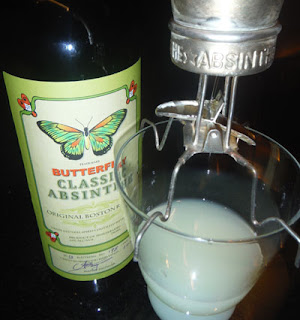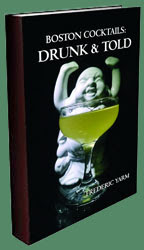1. Taught a class at Stir
As a sidenote to my publishing Drink & Tell: A Boston Cocktail Book, all of the book signings especially around the holidays and the like, I was invited to teach a class revolving around the book at Barbara Lynch's Stir (the class description can be found here). My co-conspirators were Drink's John Gertsen who made helped me plan the class and coordinated the cocktail assembly and chef Kristen Kish who paired food to the cocktail list. We picked five cocktails to present that began with the Revision and continued on to April in Paris, Tommy Noble, Prospect Park, and Northern Lights. One of the guests that night declared the Tommy Noble one of the best cocktails he has ever tasted. Yeah, Tommy S-G got double love in that list via two different bars' offerings, but he's most certainly worthy of that honor.

Having never bartended professionally before, I was called out for an event in February. For the Blue Room's Spaghetti Western-themed Whiskey and Amari night series, I was paired up with The Hawthorne's Katie Emerson. Katie and I decided on a Women of the Wild West night and came up with nine original drinks to put on the menu. The most adventurous was the choose-your-own-amaro Kitty Leroy named after one of the more infamous promiscuous rascals on the Wild West (and the drink remains on the Blue Room's regular cocktail menu), and my birthday Scaffa tribute to organizer Matt Schrage, the Madame Mustache, surprised me at how well it sold over those four hours. The event was captured in an interview on BostonChefs.
3. Teaching cocktail classes
After getting motivated to pursue bartending professionally, I started looking at BostonChef's job listings and there I spotted an ad for someone to teach a "Manhattan class." Answering that ad has turned into a once-every-three months gig teaching the new recruits of The Welcoming Committee organization how to make classic cocktails. It was great that the host expanded the concept to include gin as well as rye drinks, and each time I assembled a cluster of 10 drinks for them to make. Moreover, by word of mouth, it has spawned some catering gigs at private residences albeit with no or less teaching component.
4. Item crossed off my bucket list
I had always wanted to judge a cocktail competition and 2013 saw me judging two of them. I should definitely be careful with what I ask for. The first was a Licor 43 competition in May; the danger of this one was the number of contestants, the sugar content of a liqueur-sponsored event, and the amount of alcohol consumed. Yes, the finals included tasting the top 3 drinks again. In the end, I was left with a sugar-high, an overload of alcohol, and a bottle of liqueur and a t-shirt as thanks. Luckily, at my dinner afterwards at Estragon, Sahil Mehta was able to suggest a drink that dried out my palate and was low in alcohol to patch me up. The other judging was through the Mutineer Magazine for the Luxardo competition. Unlike the Licor 43 competition, they narrowed down the contestants to three and I had to visit each bartender where they worked. While two were in Boston, the third necessitated an excursion out to Worcester. Luckily, we paired that trip with a beer-themed brunch visit to Armsby Abbey afterwards. Judging this one was tough, but in the end, I realized how important it was to read the instructions for giving a personal reason for creating the drink and relating it to the theme can be the tipping point in an otherwise close contest. Every score-able detail counts, and as a mental note to myself as a competitor, read and re-read the contest instructions.

2013 found me dropping my search for a day job in my old field and considering a job behind the stick. One of the hurdles was finding someone to hire me. The problem was frustrating, for bar managers found me too knowledgeable (or old) to be a barback and too inexperienced to be a bartender. A few places at least let me stage for the night. Alas, Sam Gabrielli at Russell House Tavern came to the rescue and I answered his Facebook posting about needing a barback ASAP. From a response on a Saturday morning to meeting him at early afternoon to staging that night, my career path was set. I ended up barbacking and learning the ropes in the restaurant world for four weeks from May to June before being bumped up to daytime bartender in June to present. While making cocktails is a part of the job, most of the job just deals with people. And beer. Starting earlier in the year, I regained my passion for beer and began tasting, attending events, and writing about this hopsworthy beverage. In addition, I got interviewed by the OnTheBar app for how that app has helped me as both a bar-goer and a bartender. While it took a few months to feel adjusted to the career change, I am quite happy with my new restaurant family from the fellow bartenders to the servers to the guests. It is rarely a dull or usual day in Harvard Square, and when I told that to Deep Ellum's Max Toste when he was sitting at my bar, he commented that "Harvard Square... it's like the airport."

No longer was I just creating drinks for the blog, books (see #7), or one-off events, but my creations were finding a home. My Chutes & Ladders was the first to appear in August and is still going strong today, and my Downtown at Dawn has been served on menu as well. Suddenly, the product of various bartenders making my drinks began to become evident on Instagram, Twitter, Facebook, and other.
7. Cocktails and techniques appearing in books
The year found my recipes appearing in Gary Regan's The Negroni book and another accepted in his 101 Best new Cocktails 2013 book. My experiments on glass chilling made it into Kevin Liu's Craft Cocktails at Home, and things I said about shrubs will apparently appear next year in Michael Dietsch's Shrubs: An Old-Fashioned Drink for Modern Times.
8. Visited new Boston bars
New breath has been given to the Boston cocktail scene with the addition of several new bars and I wrote up a post in September about five of them that frequently got referenced by the food sites across town. I have been pleased with the vermouth- and sherry-laden offerings at Belly Wine Bar, the Tiki drinks at Blue Dragon, and the food-friendly libations at Sarma. Craigie on Main's sister, Kirkland Tap and Trotter is a welcome addition to the neighborhood. And nearby to Blue Dragon and Drink is Tavern Road making Fort Point a destination instead of a one-stop spot. I am not sure when Casa B opened, but we have enjoyed sitting at Taso's bar there this year. Harvard Square has gained the Sinclair and Beat Hotel, and I look forward to checking out Alden & Harlow soon. Others have opened like Commonwealth, State Park, Ribelle, and Fairsted Kitchen that I have not yet made it to.
9. Thirst Boston!
As a successor to the Boston Cocktail Summit, this year's event continued on the tradition of making Boston's spot in the drink world better known. I wrote up my highlights, but the focus on the Daiquiri Time Out, strange laybacks including Galliano and Bols Yogurt, and Fernet Branca twister were pretty entertaining. Talks on sherry and rum were educational in addition to me picking up an appreciation for Irish Coffee as a beverage and art form. I am glad that they made it so easy to attend for I was too busy with my new job to make it to Tales of the Cocktail or Portland Cocktail Week this year; perhaps I will find the time next year for those events.

Like previous years, I stalled out at 9. For 10, perhaps it is the randomness that working at a bar has afforded me. I have had customers come from as far away as Michigan bearing gifts of Sazerac lollipops -- guests who read the blog and found out when and where I was working. Luckily, enough people use the OnTheBar app and have followed me (to the point that I surpassed the Century Club goal). I have had the honor of reversing the situation of serving bartenders who for years had been serving me. Various industry professionals from brewers to distillers (such as Maggie from Privateer who took the above photo) have sat at my bar. Being photographed and tweeted about has been great, but I have more frequently played the roll of Boston ambassador for tourists and locals alike by giving bar, restaurant, museum, shopping and entertainment suggestions. And in one instance, saving a pair of female guests from going to places that were put on a list someone gave them -- which included the Pine Street Inn (homeless shelter) and Centerfolds (strip club, although I did not assume that they might not want to go there) that were mixed in with good suggestions. Perhaps Max Toste's comparison to an airport is quite fitting!






 The theme for this month's
The theme for this month's 


 1 1/2 oz Laird's Bonded Apple Brandy
1 1/2 oz Laird's Bonded Apple Brandy



















 Last Friday, I went to session 1 of
Last Friday, I went to session 1 of 









 The 2017 collection of 855 drink recipes, bartender tributes, and essays on hospitality from CocktailVirgin's Frederic Yarm. Available at
The 2017 collection of 855 drink recipes, bartender tributes, and essays on hospitality from CocktailVirgin's Frederic Yarm. Available at  The 2012 collection of 505 drink recipes, techniques, and Boston bar recommendations from Frederic Yarm. Available at
The 2012 collection of 505 drink recipes, techniques, and Boston bar recommendations from Frederic Yarm. Available at 



